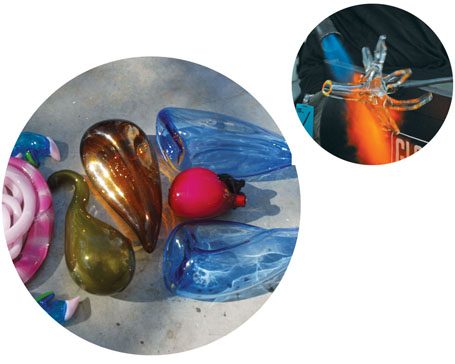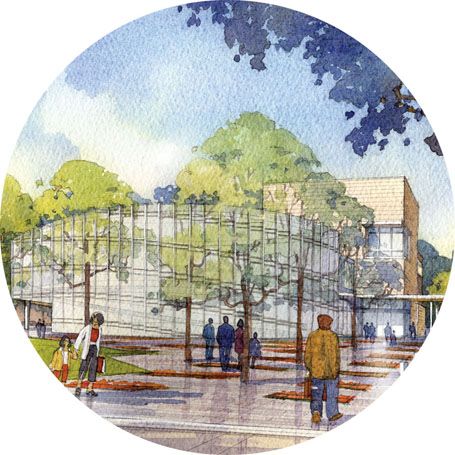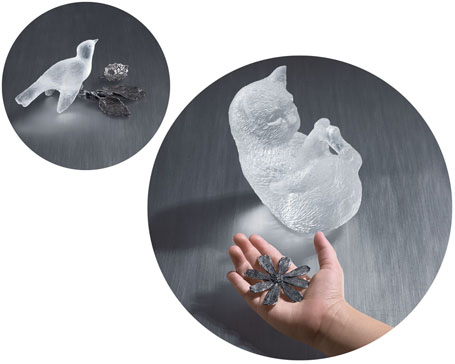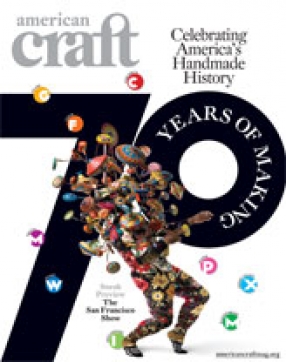


How does craft inform the design process? GlassLAB, a new collaboration between the Corning Museum of Glass and the Vitra Design Museum offers a live, up-close look at the eternal interplay, bringing Corning glassmakers and technicians together with leading designers for public demonstrations, in which concepts are rendered into hot-glass prototypes. The project made its debut at the Design Miami expo (December 6-9) with a series of “performances” featuring the designers Constantin and Laurene Boym, Paul Haigh, and Sigga Heimis of IKEA, and the Campana Brothers.
GlassLAB is an offshoot of Corning’s successful “Hot Glass Show” outreach program, which includes a state-of-the-art mobile glassmaking unit that has traveled to venues around the world (the 2002 Winter Olympics in Salt Lake City, the Powerhouse Museum in Sydney, Australia, and the Getty Villa in Los Angeles, to name a few). Next up, hot glass on the high seas: a version of the show is being custom-designed as a permanent attraction aboard four new Celebrity Cruise ships, launching next December.
A world-class museum for quilts will have its long-awaited grand opening March 30, when the International Quilt Study Center is unveiled at the University of Nebraska-Lincoln. Designed by Robert A. M. Stern, the $12-million, 37,000-square-foot, eco-friendly facility houses important holdings of 2,300 antique and contemporary quilts from around the world, including the Ardis and Robert James Collection, the Jonathan Holstein Collection (including pieces from the Whitney Museum’s famous 1971 exhibition), the Cargo Collection of African American Quilts and a group of Pennsylvania Amish works.
For its new, 6,000-square-foot satellite, set to open in June in Grand Center, St. Louis, Craft Alliance invites proposals for “non-traditional studio craft exhibitions which challenge conventional notions of craft art and underscore the vital role of craft media in contemporary art.”
The Rhode Island School of Designhttp raised a glass to its president, Roger Mandle, at a party January 16 at Christie’s New York, marking his retirement after 15 years. Donations in Mandle’s name may be made to the President’s Scholars Program at RISD, in recognition of his efforts to open the school to students from diverse economic backgrounds.
Baltimore Clayworks has launched the Mary E. Nyburg Fund for Artist Development, honoring one of its founding board members and well-loved resident artists, who died in 2006. Each year proceeds will allow a selected artist to pursue a period of “focused investigation of clay” at a recognized craft center or institution outside of Baltimore.
When the blacksmith Jim Wallace was hired in 1978 to turn a few abandoned buildings in downtown Memphis, Tennessee, into the National Ornamental Metal Museum he figured the job would be temporary. Instead he poured heart and soul into the place for three decades, nurturing it into a respected center for the advancement and conservation of art metal—jewelry, sculpture, architectural ironwork—as well as a hub for smiths from around the globe. Having stepped down in December as founding director, Wallace is proud not just of the museum’s reputation but also “that it lived and endured, because it was so marginal in the early years.” Living on the premises during his entire tenure, he was “keeper of the lighthouse”—administrator, curator, fundraiser, handyman and night watchman (the museum’s earliest security firm, he jokes, was “Winchester, Black Dog and Associates”). Guided by his long-term vision and the support of “many dedicated people who believed in the mission,” the Metal Museum steadily grew, adding a smithy, foundry and library. After an extensive search the board selected Carissa Hussong, former head of the UrbanArt Commission of Memphis, as his successor. While he’ll keep close ties to the museum, right now Wallace and his wife, Judy, are busy building a house in Norfork, Arkansas (“on the White River, so if I want to fish I can go and catch a trout”), along with a new foundry, where he’ll focus on commission work and sculpture. The shop will be up and running shortly, he notes with satisfaction: “I’ll be able to stand in front of a fire and move metal.”
Tattoos may be more mainstream these days, but they still never fail to fascinate. Now Steuben Glass has launched the Tattoo Collection by the artist Kiki Smith, inspired by her longtime interest in the tattoo as adornment and metaphor. The designs include a blown vase with Smith’s interpretations of classic tattoo symbols (a snake, flowers, stars and the like, executed by master engraver Max Erlacher), plus four small desktop sculptures that include wearable jewelry elements like Bird on a Branch and Cat with Daisy.
The weaver Lilian Tyrrell died November 20. She was 63. Born in England, she moved to the United States with her husband, the sculptor Brinsley Tyrrell, in the turbulent year of 1967; they eventually settled down in Freedom Township, Ohio. She acquired her first loom in 1974 and taught herself to weave, creating ever larger and more ambitious works—first, a series of unsettling landscapes and, from the 80s on, her powerful Disaster Blankets, which depict images of war, terrorism, pollution, genocide, racism and religious intolerance. “I consciously chose to use tapestry, an art form most commonly associated throughout history with the politically empowered, to express the problems of political and social unrest,” she wrote. “This is my personal way of dealing with the frustrations and feelings of helplessness that can accompany the information one receives with the evening news.”
Barbara-Rose Okun, 75, a longtime dealer and advocate of contemporary craft, died December 15 following a battle with cancer. Beginning in the 1970s she presented masterworks in clay, basketry and metal at her two venues in St. Louis—the Barbara Okun and Okun-Thomas Galleries—and later at the Okun Gallery in Santa Fe, where she moved in 1989. Herself an accomplished artist in fiber and metal, she served on many boards, including those of the Saint Louis Art Museum and the American Craft Council. Together with her husband, Edward, she was an avid collector of art and craft objects, showcased in their home outside Santa Fe.






Post Your Comment
Fields in bold are required. Your email address is required but not published. Please enter the five digit code as it appears in the text field on its right.